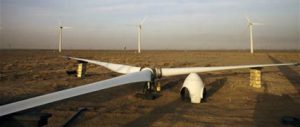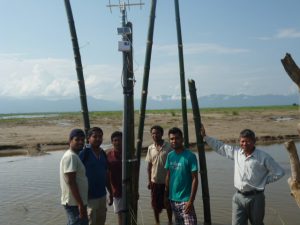Germany’s Energy transition (‘Energiewende’) has been much feted, but when it comes to energy and climate-change policy, China is the country to watch. Its burgeoning economy and voracious appetite for coal-fired power make it the world’s biggest source of greenhouse gases, generating over one quarter of man-made carbon emissions. But it’s also leading the drive for clean energy by embracing low-carbon generating technology at an unprecedented scale. That makes China a unique laboratory for studying the costs and logistics of competing power sources— and for comparing the merits of nuclear power and renewables.
China’s prodigious nuclear program currently has 17 commercial reactors operating and 28 more under construction—almost half the global total of reactors being built. The government expects to have 40 gigawatts (GW) of nuclear power on line by 2015 and at least 58 GW by 2020.
But those figures pale next to the gargantuan wind and solar programme. At the end of 2012 China had the world’s largest wind turbine capacity, 75.6 gigawatts, and it’s aiming for 100 GW by 2015 and 200 or more by 2020. Solar photovoltaic capacity is also skyrocketing: the previous 2015 target of 21 GW has been raised to 35 GW, and the 2020 target of 50 GW will likely rise as well. According to these figures, wind and solar will eclipse nuclear power in China.
Actual vs Potential Power
However, raw numbers of potential gigawatts are a misleading metric of energy production. When we measure the actual electricity generated—in trillions of watt-hours, or terrawatt-hours (TWh)—we see a very different picture: feeble, unreliable wind and solar generators are hard-pressed to match the robust output of China’s nuclear reactors. In 2012 China’s wind turbines generated 100.4 TWh, edging out nuclear’s 98.2 TWh. But last year China had just 12.8 GW of nuclear in operation — which still managed to generate almost exactly as much electricity as six times their number of wind gigawatts.
One reason for low wind productivity is the difficulty of integrating wind power into the electricity grid. Only 62.7 GW of those 75.6 GW of turbines were even connected to the grid at year’s end; since they came on line throughout the year, China’s average grid-connected wind power was just 55 GW during 2012.
China has also lagged in building long-distance transmission lines from windy prairies to coastal cities. With no way to pipe electrons from Inner Mongolian wind farms to Guangdong factories, wind power is often “curtailed” — i.e. shut down — when surges threaten to overwhelm isolated local grids. Curtailment wasted 20 TWh of China’s wind generation in 2012.
But the main cause of Chinese turbines’ abysmal performance is simply the fickleness of wind. Turbines generate their full power only under ideal wind conditions; most of the time their output is a small fraction of full power. That shortfall in generation compared to capacity is called the “capacity factor”—the total electricity produced in a year divided by the amount that would be produced if the generator ran at full power all 8760 hours. In 2012, China’s grid-connected wind turbines had a capacity factor of just 21 per cent; had there been sufficient transmission to avoid curtailment, it would have struggled up to 25 per cent. At 14%, the capacity factor of Chinese solar power is even worse, thanks to exotic weather anomalies known as “clouds” and “night.” By contrast, China’s nuclear reactors had a capacity factor of 87 per cent in 2012.
Those capacity factors mean that every gigawatt of nuclear power generates four to six times as much electricity as a gigawatt of wind or solar. Such gross disparities put China’s giant wind and solar targets in a less flattering light. Assume China meets its 2015 target of 100 GW of grid-connected onshore wind and 35 GW of solar, and throw in 5 GW of offshore wind it hopes to build by 2015, with an offshore capacity factor of perhaps 40 per cent. That 140 GW of wind and solar capacity would generate at most 279 TWh of electricity. The 2015 target of 40 GW of nuclear can produce 305 TWh—9 per cent more electricity from a little more than one quarter of the capacity.
Nuclear’s economic advantages
Nuclear electricity will also be substantially cheaper. Admittedly China’s new Generation II reactors have a construction cost of perhaps $2600 per kilowatt; additional financing costs might bring that up to $3500 per kilowatt- more than the $1500 per kilowatt price of current wind and solar installations and $2400 per kilowatt of offshore wind turbines. But nuclear’s greater productivity still makes it economically more attractive. At those prices, 40 GW of nuclear costs $140 billion to build—one third less than the $214 billion price tag for 140 GW of wind and solar, which won’t produce as much electricity. Turbines and panels have lower operating and maintenance costs, but there are many more gigawatts to operate and maintain.
The wholesale grid price of nuclear electricity, set at 0.43 yuan (US $0.07), is therefore considerably cheaper than wind-generated electricity at 0.51-0.61 yuan ($0.08-0.10) and solar electricity at 0.75 to 1.15 yuan ($0.12-$0.18). That doesn’t count the systemic grid costs of stringing power lines from steppes, deserts and oceans and balancing chaotic surges and slumps of wind and solar power. Those system costs are a big reason Chinese transmission managers are reluctant to bring wind onto the grid, even with a new renewable portfolio standard.
Investment return is another key economic difference between nuclear and renewables. High wholesale prices are locked in for a couple of decades to recoup construction costs, but once the mortgages are paid off generators can sell their power cheaply. But while nuclear plants rated to last 60 years or more will inhabit that low-cost regime for many decades, wind and solar generators will wear out more quickly, in 20 to 30 years. Indeed, none of the wind turbines and photovoltaic panels installed to meet 2020 targets will be around to help meet 2050 targets. That makes nuclear a much better investment for China.
Hydroelectric power is still the 800-pound gorilla of Chinese renewables, set to grow to 430 GW by 2020. It’s slightly cheaper than nuclear and fairly reliable on a seasonal basis despite 40 percent capacity factors. But it has large social and environmental drawbacks — the Three Gorges dam displaced 1.5 million people and flooded hundreds of square kilometers — and geographical limitations that inhibit its implementation.
So if China’s energy supply is to be comprehensively decarbonised, the burden will fall to wind, solar and nuclear. Government plans will ultimately determine which technology takes the lead, but nuclear’s cost, convenience and reliability advantages make it a strong contender. Those advantages may increase as China develops its own versions of Western Generation-III reactors.
The Chinese have avoided the delays and cost overruns that plague Western nuclear projects; economies of scale from mass deployment may further drive down costs, making it even harder for renewables to compete. And China is avidly pursuing advanced Generation IV technologies — pebble-bed reactors, fast breeder reactors, thorium reactors — that may yield safety and cost breakthroughs.
Safety concerns are, of course, a persistent concern: the Chinese nuclear rollout slowed markedly after the Fukushima accident, and some proposed nuclear installations have drawn public protest. But deepening environmental crises may change Chinese perspectives on nuclear risks. China’s coal-burning power plants are a primary contributor to its famously lethal air pollution, which kills tens of thousands of people every year, a toll far worse than that from any nuclear accident. Judging by its current performance, nuclear power can replace coal faster and more cheaply than wind and solar can— and that could make nuclear the safest option of all.







